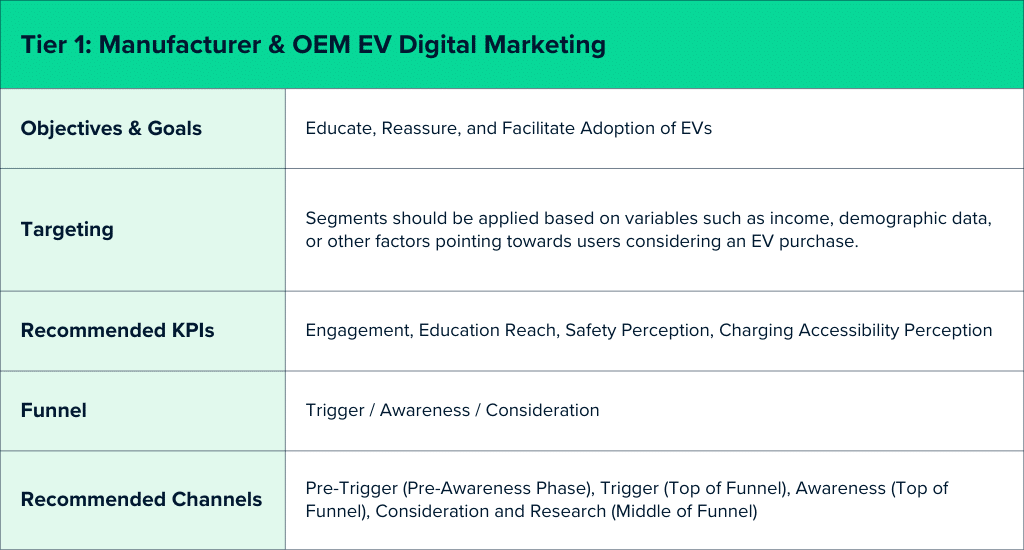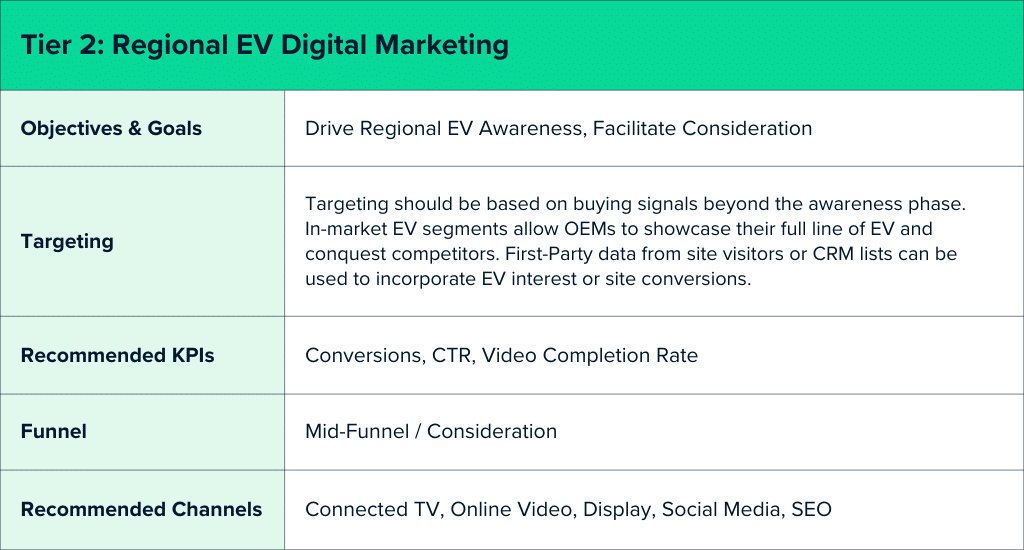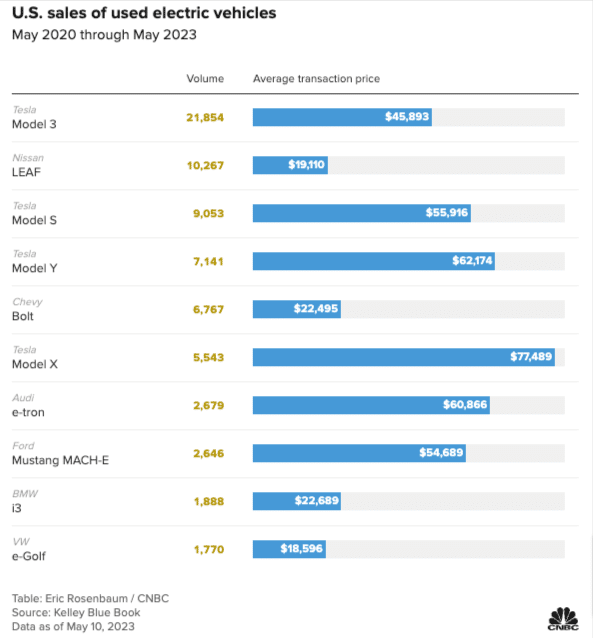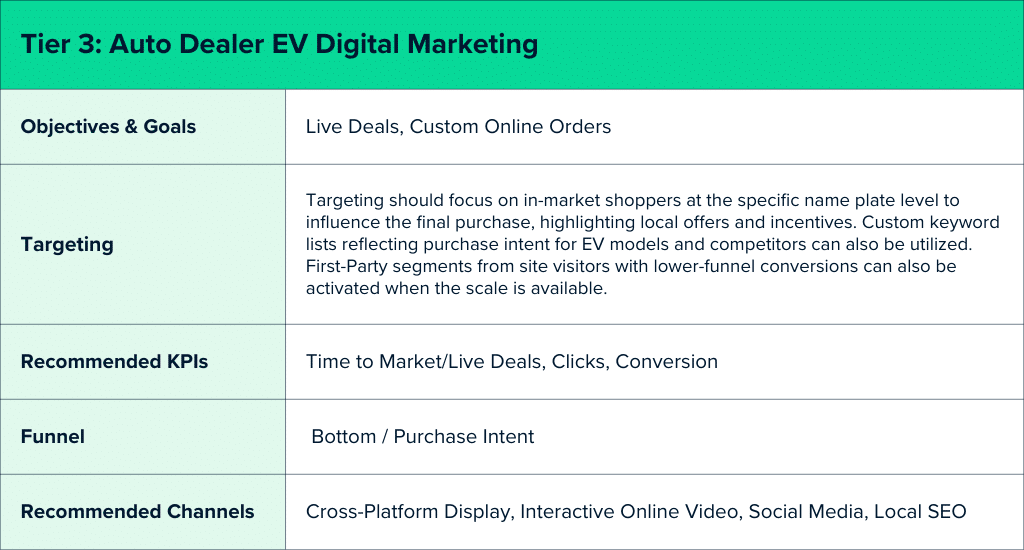In the rapidly evolving landscape of electric vehicle marketing, seizing opportunities and overcoming challenges is paramount. As the market surges forward, brands and agencies have a unique chance to shape the future of automotive marketing. By addressing range anxiety, staying abreast of regulations, and emphasizing the growth of charging infrastructure, digital marketing professionals can boost EV awareness and sales.
Join us as we dissect pivotal trends, buyer personas, and effective marketing strategies to conquer challenges and drive EV adoption.
State of US EV Market: Growing Investment Despite Challenges
The US electric vehicle (EV) market is poised for significant expansion, with the Department of Energy earmarking $15.5 billion for EV initiatives. This substantial investment, aligned with President Biden’s strategy, offers a pivotal opportunity for the automotive industry. Of this, $12 billion is designated for automotive conversion projects, while an additional $3.5 billion is allocated to bolster domestic battery production.
The EV market is experiencing robust growth, with Q2 2023 witnessing nearly 300,000 new battery-electric vehicle purchases, a 48% surge from the previous year.
Factors driving this surge include price reductions, an expanded vehicle selection, and increased investments. Industry experts anticipate over one million fully electric vehicles sold in 2023, a milestone in EV adoption. Despite promising growth, challenges like pricing and charging infrastructure persist. Efforts to address these barriers along with consistent investments and regulatory support, are crucial for sustained market growth and accessibility.
Notable EV Market Trends
Ongoing government intervention via tax breaks, new models, and used electric inventory continue to complicate and expand the EV market. Notable trends include:
1. Ongoing tax breaks to incentivize buyers.
The Inflation Reduction Act (IRA) of 2022 changed EV tax credits. Some previously ineligible models now qualify, while others no longer do. There are new price limits: large EVs must cost under $80,000, and smaller ones under $55,000. The IRA also introduced a $4,000 credit for used EVs under $25,000. These measures aim to boost EV adoption, aligning with the Department of Energy’s goal of a net-zero economy by 2050. Consumers can check eligibility on the DOE and IRS websites. Further IRA rule clarifications are expected in March 2023.
2. Tesla dominated the US EV market in H1 2023.
Despite rising competition, Tesla’s grip on the US electric vehicle market remains formidable. In the first half of 2023, Tesla outsold its next 19 rivals combined, with 325,291 EVs sold compared to their 214,542. This unparalleled dominance, where no other brand holds more than 10 percent market share, underlines Tesla’s commanding position in the US EV landscape. The Model Y and Model 3 led the pack with 200,000 and 160,000 sales.
3. Surge in new models in 2024 from major manufacturers.
A surge in new electric vehicle (EV) models is anticipated by the end of 2024, covering various types, including cars, SUVs, and pickups. Major automakers like Acura, Chevrolet, and Hyundai are introducing competitive models. For instance, the Acura ZDX, co-developed with General Motors, is set to challenge rivals with its estimated 340 hp and range of up to 325 miles. Meanwhile, based on the Ultium platform, Chevrolet’s Blazer EV will offer trims with ranges varying from 293 to 557 miles. Moreover, Hyundai’s Kona EV is slated for release with short- and long-range battery options. This proliferation of options indicates a significant shift towards electric mobility in the coming years.
4. Expanding EV charging infrastructure.
The expansion of EV charging infrastructure is a pivotal focus in the drive towards widespread electric vehicle adoption. The Bipartisan Infrastructure Law in November 2021 allocated $5 billion for states to strategically develop charging stations, with an additional $2.5 billion for a competitive grant program. Luxury car manufacturers invest in networks with exclusive benefits for their vehicle owners. Private companies and network operators are aggressively expanding charging networks, prioritizing cities like Detroit, Dallas, Nashville, and Orlando. New stations boast enhanced payment options, larger transaction screens, and higher power outputs for faster charging.

Electric Vehicle Charging Station Locations from Energy.gov
5. At-home charging growing & improving.
The Bipartisan Infrastructure Law (BIL) supports at-home EV charging stations. It introduces a federal tax credit covering 30% of equipment costs (up to $1,000 per unit) for individuals. New 2022 technology allows for chargers without requiring electrical panel upgrades, reducing installation costs. Advanced features include app connectivity for seamless control of connected devices. Additionally, an extended residential solar photovoltaic system tax credit offers homeowners a 30% for the next decade, covering solar panels, labor, fees, and energy storage devices with a capacity rating of 3 kWh or more.
6. Used electric vehicles hit the market.
As the EV market expands, so does the availability of used electric vehicles (EVs). With over 2.2 million EVs on the road, sales are projected to exceed one million this year. However, there are specific considerations for buyers. Understanding battery degradation, which can lead to costly replacements, is essential.
While EVs depreciate faster, they offer lower maintenance costs. Used EVs also qualify for state and federal incentives, making them an appealing option for budget-conscious consumers.
What emerging tech do you see influencing the marketing of electric vehicles in the coming years?
“AI. Specifically for personalization. We’re B2B – our customers are fleet operators (car rental, taxis, company cars, etc). The common questions and concerns about EVs, such as range anxiety and charging infrastructure, are amplified when discussing managing and optimizing dozens of vehicles at a time.

Purchaser Demographics: Who is Buying EVs in 2023?
Despite a major focus on EVs from the US government and major manufacturers, most vehicle intenders are not necessarily considering an EV for their next purchase.
According to Pew Research (2023), approximately 38% of Americans are open to considering an electric vehicle for their next purchase. Younger adults and urban residents exhibit higher interest. Saving on gas (70%) and environmental impact (72%) are major motivators.
Confidence in future EV infrastructure is low, with 17% extremely or very confident. Support for phasing out gas-powered vehicles by 2035 has declined to 40%, with 59% opposed. Emotional reactions to this idea vary, with 73% feeling upset if gasoline vehicle production ceased.

Customer Persona: Emily Green
Overcoming Challenges in EV Marketing: Proactive Education
Navigating the path toward widespread electric vehicle adoption comes with several hurdles. Confronting these challenges head-on is crucial for a successful EV marketing strategy.
By proactively tackling these obstacles, EV marketers can cultivate a more informed and confident consumer base. Through education, advocacy, and strategic partnerships, the transition toward electric vehicle adoption can be facilitated, ultimately paving the way for a sustainable automotive future.
1. Range Anxiety and Misconceptions
The Challenge: Range anxiety, a concern about the distance an electric vehicle can travel on a single charge, has been a prevalent obstacle. Additionally, misconceptions about EVs’ capabilities and charging infrastructure can deter potential buyers. According to a June 2023 survey from Verra Mobility, 79% of drivers have concerns regarding range and charging EV vehicles.
The Solution: Educating potential buyers is key. Providing accurate information about the range of capabilities of modern EVs, along with highlighting the advancements in battery technology, can dispel these anxieties. Test drives and real-world testimonials can also showcase the practicality of EVs in daily life.
2. Regulatory & Policy Challenges
The Challenge: Evolving regulations and policies regarding emissions, incentives, and infrastructure can be complex and vary by region. This can create uncertainty for both manufacturers and consumers.
The Solution: Staying abreast of local and national policies is essential. Offering guidance on available incentives, tax credits, and rebates can incentivize potential buyers to consider EVs. Collaboration with advocacy groups and participation in policy discussions help shape a conducive environment for EV adoption.
3. Charging Infrastructure Concerns
The Challenge: The availability and accessibility of charging stations are pivotal concerns. Potential buyers worry about the convenience and reliability of charging infrastructure, particularly on long journeys.
The Solution: Highlighting the growth of charging networks and emphasizing the convenience of home charging can reassure potential buyers. Partnerships with charging networks and investments in expanding infrastructure can further bolster confidence in the viability of EVs.
4. Safety Concerns
The Challenge: Isolated incidents of fires involving electric vehicles, like those from Tesla, have raised safety concerns among potential buyers. This issue has decreased over the past years, but isolated incidents in the news could bring this to the forefront of buyer’s minds. As of June 2023, 78% of respondents thought EVs were safer or as safe as gas-powered vehicles.
The Solution: Emphasizing the rigorous safety standards adhered to by EV manufacturers and the continuous advancements in battery technology is essential. Sharing comparative safety data and showcasing the numerous safety features of EVs can help dispel apprehensions. Brand recognition and trust earned by the big 3 auto manufacturers may also help assuage these fears.
🪫 EV Experience: Debacle in SoCal
“AI. Specifically for personalization. We’re B2B – our customers are fleet operators (car rental, taxis, company cars, etc). The common questions and concerns about EVs, such as range anxiety and charging infrastructure, are amplified when discussing managing and optimizing dozens of vehicles at a time.

Electric Vehicle Marketing Funnel & Buyer’s Journey
Embarking on the journey towards EV ownership involves distinct stages, each with unique considerations.
From initial curiosity to the final decision-making, understanding these phases is crucial for effective digital marketing.
Pre-Trigger (Pre-Awareness Phase)

In this preliminary phase, potential buyers are in the early stages of considering an electric vehicle (EV) as their next car. They may have a budding curiosity about EVs and a growing awareness of their benefits despite not needing a new car. They have not reached a trigger point or decided to buy a new car.
These individuals might think, “My next car will be an EV.” These buyers may also be eager to be seen as early adopters of the EV revolution.
Key characteristics of this phase include:
- Curiosity & Interest in EVs: Potential buyers are starting to explore the world of electric vehicles, showing interest in their environmental benefits, cost savings, and technological advancements.
- Information Gathering: They may be actively seeking information online, reading articles, watching videos, and engaging in discussions to learn more about EV options.
- Brand Neutrality: At this stage, potential buyers might not have a strong brand preference and are open to considering various manufacturers.
To engage potential buyers in this phase, marketers can employ strategies such as:
- Educational Content & Advertisements: Providing easily accessible content that introduces the benefits of EV ownership, explains key concepts (e.g., charging infrastructure, battery technology), and showcases the advantages of specific models.
- Press and Sponsorships: Host events where experts discuss the benefits and considerations of choosing an EV. Key influencers and brand partnerships may help here, as well.
- Interactive Tools: Offering tools like range calculators or quizzes to help potential buyers assess their specific needs and preferences in an electric vehicle.
By acknowledging and catering to the pre-trigger phase, marketers can nurture early-stage interest and guide potential buyers toward a deeper understanding and appreciation of electric vehicles. This proactive approach sets the stage for a smoother transition into the subsequent phases of the EV buying journey.
Trigger (Top of Funnel)

At this initial stage, potential EV buyers are recognizing their need or desire for a new vehicle. In addition to traditional triggers like life changes that force the issue of a new car , they are either considering or have chosen to make their next car an electric vehicle.
Triggers for considering an EV may arise from:
- Lifestyle Change: The buyer may need a new car for a variety of reasons, including a growing family, relocation, new job, etc.
- Environmental Consciousness: A growing awareness of environmental issues and a desire to reduce carbon footprint.
- Economic Considerations: Factors like fluctuating gas prices or government incentives for electric vehicle ownership.
- Technological Advancements: Exposure to innovative EV technology through media or word of mouth.
Awareness (Top of Funnel)
Electric vehicle purchases may choose to go electric at their trigger point or continue considering the option throughout their awareness and consideration phases.
In the awareness phase, potential buyers learn about EV brands and models to find one that aligns with their needs and values. Marketing and advertising are crucial in pushing buyers further down the funnel by creating EV-specific awareness through targeted messaging.
During this stage, buyers contemplate fundamental aspects such as EV vs. traditional combustion engine, vehicle size (e.g., compact or SUV), budget considerations, and essential features like electric range, charging infrastructure, and connectivity.
Key marketing channels in this stage encompass:
- Social Media Advertising: Engaging ad campaigns on platforms like Facebook and Instagram that highlight the benefits and features of EVs.
- Online Video Content: Informative videos showcasing the advantages of electric vehicles, including range, performance, and sustainability.
- Educational Blog Posts: Content that addresses common questions and concerns about EV ownership, establishing the brand as a trusted authority.
Consideration & Research (Middle of Funnel)

At this juncture, potential EV buyers have chosen to go electric and narrow their choices to specific EV models and brands. They conduct thorough research to compare technical specifications, pricing, and consumer reviews.
Marketing strategies for this phase may involve:
- Comparison Tools: Providing interactive tools on the brand’s website for potential buyers to compare different EV models based on key metrics like range, charging speed, and features.
- Review Platforms: Encouraging satisfied EV owners to share their experiences on reputable review sites to build trust and credibility.
- Live Demonstrations: Live events or webinars showcasing the benefits and features of specific EV models.
Buying (Bottom of Funnel)

In the final stage, potential EV buyers have decided on a specific brand and model and are ready to purchase. They are also likely researching trade-ins, tax breaks, and financing options.
Marketing tactics for this phase should address the following:
- On-Site Expertise: EV buyers considering going electric likely have many questions, even after their research. Dealers and showrooms must have a trained staff with several on-site experts for these customers.
- Test Drives & Showroom Visits: Encouraging potential buyers to visit dealerships for test drives and in-person consultations.
- Online Ordering and Customization: Offering the option to configure and order an EV online, allowing buyers to personalize features like color and accessories.
- Online Retail Platforms: Facilitating seamless online purchases through trusted platforms for buyers who prefer a direct online buying experience.
By tailoring marketing efforts to the unique stages of the EV buying journey, digital marketers can effectively guide potential buyers toward embracing electric vehicle ownership.
Electric Vehicle Marketing Across Automotive Tiers
From educating potential buyers to driving local engagement, successful electric vehicle (EV) marketing demands a tailored approach at every stage. Explore the strategies to boost EV consideration and purchases below.
Tier 1 Automotive Digital Marketing for EV Buyers

Tier 1 automotive marketing in the electric vehicle (EV) space requires a strategic approach tailored to potential EV buyers’ unique needs and considerations. The shift towards electric mobility demands a focus on education, reassurance, and accessibility to drive consumer confidence and adoption.
Primary Objectives & Goals: Educate, Reassure, and Facilitate Adoption of EVs
Recommended KPIs: Engagement, Education Reach, Safety Perception, Charging Accessibility Perception
Funnel: Pre-Trigger (Pre-Awareness Phase), Trigger (Top of Funnel), Awareness (Top of Funnel), Consideration and Research (Middle of Funnel)
Targeting: Leverage Interest Signals, Buyer Personas
Recommended Tactics:
- Educational Content & Advertisements: Provide accessible content that introduces the benefits of EV ownership, explains key concepts, and showcases the advantages of specific models.
- Safety Features Highlight: Share detailed information about the safety features integrated into EVs to build trust and confidence.
- Charging Network Expansion Updates: Keep potential buyers informed about the growth and accessibility of charging networks, both public and home-based.
Tier 2 Automotive Digital Marketing for EV Buyers

Tier 2 automotive marketing for electric vehicles (EVs) is regionally focused, targeting potential buyers in the consideration stage. The goal is to drive regional EV awareness and facilitate informed decision-making.
Objectives & Goals: Drive Regional EV Awareness, Facilitate Consideration
Recommended KPIs: Conversions, CTR, Video Completion Rate
Funnel: Mid-Funnel / Consideration
Targeting: Leverage Buying Signals, First-Party Data for Precision
Effective targeting relies on identifying consumers beyond initial awareness who are actively considering EVs. First-Party data integration allows for personalized outreach based on purchase history or previous site interactions.
Channels: Tailored Strategies for Regional EV Promotion
- Connected TV: Deliver engaging EV content to regional audiences through targeted campaigns.
- Online Video: Showcase the benefits and features of specific EV models to drive consideration.
- Display: Highlight key attributes of EVs and capture potential buyers’ attention.
- Social Media: Engage with consumers considering EVs on platforms like Facebook, Instagram, and Twitter.
- SEO: Optimize content for easy access to relevant information about electric vehicle options.
By tailoring Tier 2 automotive marketing strategies, manufacturers can effectively drive regional awareness and consideration, contributing to the broader adoption of electric vehicles.
Tier 3 Auto Dealer Digital Marketing for EV Buyers
Tier 3 automotive marketing for electric vehicles (EVs) is hyper-localized, focusing on driving consumers to the dealer lot during the final stages of the purchase journey.
Objectives & Goals: Facilitate Live Deals
Recommended KPIs: Time to Market/Live Deals, Clicks, Conversions
Funnel: Bottom / Purchase Inten
Targeting: Precision for Final Purchase Influence
Tier 3 marketing hones in on in-market shoppers at the specific nameplate level, utilizing custom keyword lists and First-Party segments.
This strategy aims to influence the final purchase decision by highlighting local offers and incentives. Additionally, activating First-Party segments from site visitors with lower-funnel conversions can further refine targeting when scale allows.
Channels: Driving Local Engagement and Conversions
- Cross-Platform Display: Efficient and scalable for geo-targeting, focusing on in-market shoppers to encourage on-site visits.
- Interactive Online Video: Engaging video content can showcase EV features and promotions to capture final purchase intent.
- Social Media: Leverage local platforms to promote dealer-specific offers and incentives, driving potential buyers to the lot.
- Local SEO: Optimize content for easy access to local dealer information, ensuring potential buyers can easily find and visit the dealership.
By tailoring Tier 3 automotive marketing strategies, dealers can effectively drive local engagement and conversions, ultimately leading to increased EV sales.
Beyond the Gas Pump: Strategies for Dominating the EV Market
The US electric vehicle market is on the brink of a transformative surge, backed by a $15.5 billion investment from the Department of Energy. This unprecedented opportunity and a 48% surge in Q2 2023 EV purchases set the stage for a monumental shift in the automotive industry.
With a tailored approach across automotive tiers, from educating potential buyers to driving local engagement, brands, and agencies can lead the charge toward widespread EV adoption.
About the Author
Chris Rowell is the Co-Founder and CRO at KORTX.




